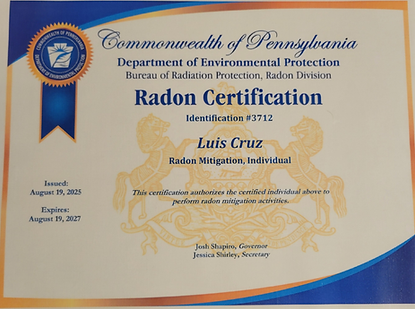
ABOUT US & OUR COMPANY
Radon is a radioactive gas that forms naturally when uranium, thorium, or radium, which are radioactive metals break down in rocks, soil and groundwater. People can be exposed to radon primarily from breathing radon in air that comes through cracks and gaps in buildings and homes.
Radon is the number one cause of lung cancer among non-smokers, according to EPA estimates. Overall, radon is the second leading cause of lung cancer. Radon is responsible for about 21,000 lung cancer deaths every year.
The EPA recommends homes be fixed if the radon level is 4 pCi/L (picocuries per liter) or more. Because there is no known safe level of exposure to radon, the EPA also recommends that Americans consider fixing their home for radon levels between 2 pCi/L and 4 pCi/L
Once testing shows elevated radon levels, contact Lehigh Radon Solutions immediately to begin the radon mitigation process and bring your home to the lowest possible radon levels.
Radon-222 is the decay product of radium-226. Radon-222 and its parent, radium-226, are part of the long decay chain for uranium-238. Since uranium is essentially ubiquitous (being or seeming to be everywhere at the same time) in the earth's crust, radium-226 and radon-222 are present in almost all rock and all soil and water.
The amount of radon in the soil depends on soil chemistry, which varies from one house to the next. Radon levels in the soil range from a few hundred to several thousands of pCi/L (picocuries per liter) in air. The amount of radon that escapes from the soil to enter the house depends on the weather, soil porosity, soil moisture, and the suction within the house.
Any home may have a radon problem.
Radon is a radioactive gas. It comes from the natural decay of uranium that is found in nearly all soils. It typically moves up through the ground to the air above and into your home through cracks and other holes in the foundation. Your home traps radon inside, where it can build up. Any home may have a radon problem. This means new and old homes, well-sealed and drafty homes, and homes with or without basements.
Radon from soil gas is the main cause of radon problems. Sometimes radon enters the home through well water. In a small number of homes, the building materials can give off radon, too. However, building materials rarely cause radon problems by themselves.
The EPA already has a wealth of scientific data on the relationship between radon exposure and the development of lung cancer. The scientific experts agree that the occupational miner data is a very solid base from which to estimate risk of lung cancer deaths annually. While residential radon epidemiology studies will improve what we know about radon, they will not supersede the occupational data. Health authorities like the Centers for Disease Control (CDC), the Surgeon General, the American Lung Association, the American Medical Association, and others agree that we know enough now to recommend radon testing and to encourage public action when levels are above 4 pCi/L (150 becquerels per cubic meter (Bq/m3)). The most comprehensive of these efforts has been the National Academy of Science's Biological Effects of Ionizing Radiation (BEIR VI) Report. This report reinforces that radon is the second-leading cause of lung cancer and is a serious public health problem. As in the case of cigarette smoking, it would probably take many years and rigorous scientific research to produce the composite data needed to make an even more definitive conclusion.
The World Health Organization (WHO), the National Academy of Sciences, the US Department of Health and Human Services, as well as the EPA, have classified radon as a known human carcinogen, because of the wealth of biological and epidemiological evidence and data showing the connection between exposure to radon and lung cancer in humans.
There have been many studies conducted by many different organizations in many nations around the world to examine the relationship of radon exposure and human lung cancer. The largest and most recent of these was an international study, led by the National Cancer Institute (NCI), which examined the data on 68,000 underground miners who were exposed to a wide range of radon levels. The studies of miners are very useful because the subjects are humans, not rats, as in many cancer research studies. These miners are dying of lung cancer at 5 times the rate expected for the general population. Over many years scientists around the world have conducted exhaustive research to verify the cause-effect relationship between radon exposure and the observed increased lung cancer deaths in these miners and to eliminate other possible causes.
In addition, there is an overlap between radon exposures received by miners who got lung cancer and the exposures people would receive over their lifetime in a home at the EPA's action level of 4 pCi/L (picocuries per liter of air), i.e., the lung cancer risk in miners has been documented at exposure levels comparable to those which occur in homes/residences.
There are no immediate symptoms from exposures to radon. Based on an updated Assessment of Risk for Radon in Homes, radon in indoor air is estimated to cause about 21,000 lung cancer deaths each year in the United States. Smokers are at higher risk of developing radon-induced lung cancer. Lung cancer is the only health effect which has been definitively linked with radon exposure. Lung cancer would usually occur years (5-25) after exposure.
If it is maintained, the basic components should last for many years. The in-line fans usually have a five-year warranty but can last for much longer. The important thing is to have your home retested every 2-3 years by an NRPP Certified Tester who can also inspect the system to determine if repairs or updates need to be made.
There is no way to know if the system is working unless you have a test is performed. Generally, when builders install a radon system, it means rough-in measures were taken that will hopefully make it easy to activate with a fan in the event the test results are elevated. But, don’t expect it to have been tested already; make sure you have a test performed during your inspection period.
Elevated radon has been found in buildings with all foundation types and in every county in the country. All homes should be tested regardless of geographic location or foundation type.
Radon is a colorless, odorless, naturally occurring, inert radioactive gas that comes from the decay of radium is the only gaseous element of the long, uranium-238 radioactive decay chain. Uranium and radium are commonly found in soil and rocks around the world. People can be exposed to radon primarily from breathing radon-laden air that enters through cracks and gaps in the building’s foundation. According to the U.S. Environmental Protection Agency, the National Academy of Sciences and the Center for Disease Control, indoor radon exposure is the leading cause of lung cancer in non- smokers, responsible for more than 20,000 U.S. lung cancer deaths each year. When you breathe in radon, radioactive particles from radon gas can get trapped in your lungs, where they can damage DNA as they release alpha radiation. The only way to know your home or building contains dangerous radon levels is to have a test performed.
Radon is a radioactive gas and there is no safe level. Consumers should be aware that U.S. EPA’s estimate of 21,000 annual deaths from radon induced lung cancer in the U.S. was based on an average level of 1.3 picocuries per liter of air. The EPA Action Level of 4 picocuries/per liter of air (pCi/L) was based on the achievability of early radon mitigation technology from three decades ago. Annual exposure to 4 pCi/l is the equivalent of 200 chest x-rays per year. The World Health Organization recommends indoor radon should not exceed 100 Bq/m3 (Becquerel per cubic meter) which equates to 2.7 pCi/L. Lung cancer risk rises 16% per 2.7 pCi/L increase in radon exposure.

Who We Are
We are proud to be a local small business owned and operated in the Lehigh Valley, passionate about health, safety, and doing things right the first time. Because when it comes to radon, we understand we are slowly but surely saving lives.
Our team is trained in EPA guidelines, DEP & NRPP certified using the latest industry techniques to accurately and effectively provide the best solutions to your homes radon issues. From activating a passive system, installing a simple system, or tackling a complex "problem home" count on us to get you to the lowest possible levels of radon. If radon is your problem, trust that Lehigh Radon has the Solution. Don't wait, call or email us today and we will help you get started!
Meet Our Team
.png)
Radon Mitigation Specialist
Luis Cruz
NRPP Certification# 115299-RMS
DEP Certification# 3317
.png)
We value:
Clear Communication – So you understand what’s happening every step of the way.
Integrity – No scare tactics, just honest and effective solutions.
Dedicated to Workmanship – We treat every home as if we were servicing our own mother's home.
